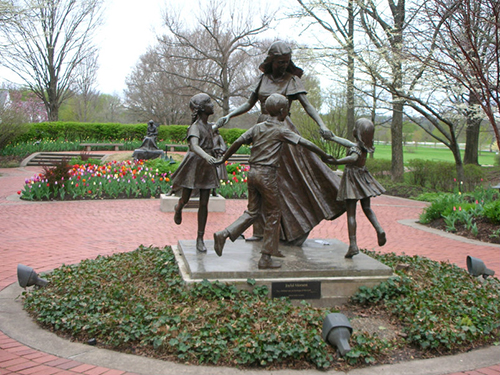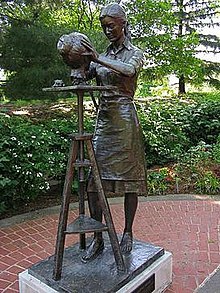Monument to Women Memorial Garden
The Monument to Women Memorial Garden is a two-acre garden with twelve statues depicting traditional women’s roles. It is located behind the Nauvoo Visitors’ Center in Nauvoo, Illinois, and owned by The Church of Jesus Christ of Latter-day Saints.
Belle Spafford, who was concluding her service as Relief Society general president, told Church president Spencer W. Kimball that the “Relief Society monument placed in Nauvoo on July 26, 1933, ‘adjacent to the foundations stones of the Joseph Smith store in Nauvoo’ had ‘deteriorated to the point that it needed to be replaced’ and was ‘not a credit to Relief Society, to the Church, to the Nauvoo Restoration efforts, or to the great worldwide woman’s movement.’ Spafford hoped that her successor would replace the old monument with a larger monument erected ‘in honor of the organization of the Society . . . on land as nearly adjacent to the Nauvoo Temple Square as possible.’”[1]
In 1974, President Kimball asked newly called Relief Society general president Barbara B. Smith if she were interested in undertaking a project to promote such a monument. She was.
During the 1970s, women’s role in society was being questioned and scrutinized.
- Never before or since the decade of the 1970s has so much been said or written about women’s role and place in American society. Traditionalists trumpeted woman’s role as unchanging: like her mother, grandmother, and female ancestors for millennia, the ideal woman was a mother, nurturing the rising generation in the home. Feminists labeled the traditional role as stereotypical, confining, and demeaning. Feminists demanded professional opportunities for women and put forward the Equal Rights Amendment, which stated “equality of rights under the law shall not be denied or abridged by the United States or by any State on account of sex,” as a solution to problems that had vexed women for centuries in the nation. Within The Church of Jesus Christ of Latter-day Saints, strident voices were heard on both sides of the ERA even after Church leaders had labeled the proposed amendment as a danger to the time-honored moral values that safeguarded womanhood and the sanctity of the family.[2]
The Monument to Women was envisioned to be a tribute to women at a time when the Church felt it urgent to define the roles of women to the world. Thirteen statues were to be placed in a garden setting illustrating the various stewardships and responsibilities of women. Florence Hansen sculpted two of the pieces, and Dennis Smith designed the project and sculpted the other eleven pieces. Smith spoke of a “garden setting with brick walks and flowing circles” that unfolded “the story of woman’s journey toward perfection” and portrayed the “ever-widening circles of her service and influence.” With the statues were scriptural verses engraved on plaques.
The garden was paid for through donations from predominantly women throughout the United States, Latin America, and the Far East.
In a statement prepared for the press, the Relief Society general presidency said, “The deeply significant figures are not only a pleasure to the eye, they are an enduring statement about women, a vision of the divine potential of the daughters of God, which we want to share with the world.”[3]
The Monument to Women Memorial Garden was dedicated by President Spencer W. Kimball in three dedicatory services held on June 28–30, 1978.
The Equal Rights Amendment debate continued for four months following the dedication of the garden. The First Presidency sent a letter in October 1978, addressed to “General Authorities, Regional Representatives, Stake Presidents, Mission Presidents, Bishops, and Branch Presidents in the United States,” stating:
- With the nation facing the prospect of continuing debate on the proposed Equal Rights Amendment, we take this opportunity again to bring to your attention our position on this important question. . . . While the enactment or rejection of the Equal Rights Amendment must be accomplished by recognized political processes, we are convinced that because of its predictable results the matter is basically a moral rather than a political issue; and because of our serious concern over these moral implications, we have spoken against ratification, and without equivocation do so again. . . . Because of our serious concern, we urge our people to join actively with other citizens who share our concerns and who are engaged in working to reject this measure on the basis of its threat to the moral climate of the future.[4]
“Hundreds of Latter-day Saint women heeded the prophetic call and participated in conferences and rallies, using their time, talents, and means to oppose the ERA. Contrary to various news reports, Latter-day Saint women who did not agree with such tactics were not threatened or denied Church membership. Yet foul play was called by proponents of the ERA, who failed to see the proposed amendment as a strike against morality and the traditional family.”[5]
The ERA failed to meet the requisite number of state ratifications (38) by Congress’ deadline of June 30, 1982, so it was not adopted as a Constitutional amendment.
- In the 2010s, due in part to fourth-wave feminism and the Me Too movement, interest in getting the ERA adopted was revived. In 2017, Nevada became the first state to ratify the ERA after the expiration of both deadlines, and Illinois followed in 2018. In 2020, Virginia's General Assembly passed a ratification resolution for the ERA, claiming to bring the number of ratifications to 38. However, experts and advocates have acknowledged legal uncertainty about the consequences of the Virginian ratification, due to expired deadlines and five states' revocations.[6]
In an essay published in 2015, Susan Easton Black wrote of the current state of the garden.
- The grand and glorious Monument to Women Memorial Garden, one of only two Church-funded projects in Nauvoo (the other being the reconstruction of the Nauvoo Temple), has gone unnoticed by succeeding generations of Latter-day Saint women. What Barbara B. Smith had believed was the heart of Nauvoo and the best site for the monument is now a distant corner of Latter-day Saint restoration efforts in the historic town. The statues are tucked away out of sight, the brick circles are cracked, and the landscape is so overgrown that the statues cannot be seen from the parking lot of the Nauvoo Visitors’ Center. There is not a missionary standing in the garden to remind visitors of the ERA or of the Latter-day Saint response to it. Although the bronze statues still look new, few visitors to historic Nauvoo discover them. Latter-day Saint women today are as unfamiliar with the monument as they are with the proposed ERA. Like so many of our imprints of the present, the monument is largely forgotten. The angry ERA debates that so permeated the volatile decade of the 1970s are rapidly becoming vestiges of the past. A new generation grapples with other societal issues that threaten the home, and so it will be from decade to decade. Few, if any, look to a forgotten garden nestled in Nauvoo for the answer.
- As I embrace the future with all of its unknowns, I pause to remember the Monument to Women Memorial Garden and my opportunity to represent BYU at the dedicatory events. I saw firsthand the work of Belva B. Ashton of the Relief Society general board and her committee of sixteen stake Relief Society presidents from Nebraska, Wisconsin, Iowa, Missouri, and Illinois and their work on programs, tickets, information sheets, and maps with reference points to parking, chemical toilets, public telephones, food courts, shuttle service, and shuttle stops. I watched D. C. Young and his crew of Nauvoo residents erect a block-long, yellow-striped tent and set up folding chairs, a podium, a sound system, and lights. I saw other volunteers cover tables with checked tablecloths, erect yellow canopies throughout historic Nauvoo, and make food items available for crowds of women near Brigham Young’s home, Lucy Mack Smith’s home, and the Cultural Hall in historic Nauvoo. Like so many guests, I ordered porcelain statues of the monument to replace the “Relief Society glass grapes” of the 1960s that adorned my coffee table. I entered the two-acre monument and walked through what appeared to be a Norman Rockwell painting—a throwback to a gentler American society. It was a nostalgic remembrance of a simpler, more traditional time in American society, a time that resonated with my mother but not with me. However, the statue Woman and Her Talents captured my attention, for it depicts a woman in a short skirt plying her talent by sculpting a face. As I looked closer, I discovered that the woman was sculpting the same face depicted on the much older woman in the statue Fulfillment and realized anew that the woman of the present must prepare to become the woman of the future. Touched by a bronzed statement in historic Nauvoo, I began to mold my future much like the woman depicted in Woman and Her Talents.[7]

